General. Later, psychiatric
Having enjoyed a community celebration of the wedding of the Prince of Wales (later King Edward VII) to Princess Alexandra of Denmark in 1863, the Richmond residents found that some £40 was left over and a committee was formed with a view to establishing a hospital for the area.
The Richmond Infirmary opened in 1868 in Rosedale, a house in Kew Foot Lane, which was rented for £100 a year. The Infirmary had 15 beds. It treated acute medical and surgical cases and was 'free to every case of accident or emergency'.
The Duke of Cambridge became its first Royal Patron in 1873.
In 1892 a new wing - the Cambridge Wing - was officially opened by the Duchess of Teck. Plans were made to build further extensions, including a children's ward. Princess May, the future Duchess of York, had been aware of the need for a children's ward as her future husband presided over the Hospital's administrative meetings. She took up the matter and raised the sum of £500 among her friends. The estimated cost of the building work was £5,700 and, by 1893, some £3,856 had been raised. Subscriptions from various sources and the financial results of two formal Dinners, presided over by the Duke of Cambridge, collected enough funds to within £300 of the full discharge of the debt. (At this time the average cost of keeping an in-patient per day was just under 4s 5d (22p).
In 1895 Queen Victoria became the Infirmary's Patron and directed that it should be known as the Royal Hospital, Richmond.
In July 1896 Princess May's Ward for Children was officially opened by the Duke and Duchess of York, accompanied by the Duke and Duchess of Teck. They had been received by the Duke of Cambridge, the President of the Hospital. The new ward contained 14 cots, a ward kitchen, a spacious bathroom and a lavatory. It was furnished with the most modern principles of sanitation. The flooring was of polished oak, while the walls were decorated with glazed Oude and Parian cement in a shade of pale green. The Hospital then had 40 beds and cots. In addition, a new Nurses' Home was built at the same time at the end of the Hospital, away from the wards. It was a square block with a marble staircase. Each nurse had her own spacious room overlooking Richmond Park. The sitting room was comfortably furnished. The total cost of the new buildings was £6,235.
By this time very little remained of Rosedale, the original old house, except for the panelled halls and wide oak staircase beyond the facade, as well as the panelled chamber supposed to have been the study of the poet James Thomson. The latter became Matron's sitting room.
In 1901 King Edward VII became Patron. The Nurses' Home had freed up space in the ward buildings and the Hospital had 60 beds. It was considered up-to-date and enjoyed great popularity in the surrounding district, providing surgical treatment for appendicitis, abscesses, burns and scalds, caries and necrosis, cellulitis, cerebral concussion, contusions, disorders of the eye, nose and ear, fractures, hernia, rectal disease, tuberculosis, tumours, gastrointestinal diseases and wounds. Medical admissions were for anaemia, Bright's disease, bronchitis, pleurisy, pneumonia, alcoholism, cirrhosis of the liver, gastric ulcer, gastrointestinal disorders, heart disease, disorders of the nervous system, phthisis (TB), uterine disease and skin disease.
An Extension Fund was established to raise £5,000 for a new Out-Patients Department and Dispensary, the existing ones having become inadequate. They had remained unchanged since 1881, when 2,481 patients had been seen (in 1901 there had been 4,116 out-patients). In 1903 the Hospital received two legacies, one of £1,000 and one of £5,000, as well as a gift of £1,000 from Mr and Mrs J.B. Hilditch of Asgill House, Richmond, towards the cost of the new Out-Patients waiting hall. Building work for the new Out-Patients Wing began in 1903. In the same year, Mr John Heneage of Richmond Hill bequeathed a further £8,000 to the Hospital. These monies enabled the Hospital Committee to erect a new building to contain the Out-Patients Department, an Ophthalmic Department and additional bedroom accommodation for the staff.
The new Out-Patients Wing was officially opened in July 1904 by the Duchess of Albany. The new wing contained consulting and examination rooms, special rooms for eye, ear and throat examinations, and an X-ray room, as well as a Dispensary. The waiting hall had an open-timbered roof, with enriched plaster panels between the roof trusses, and a large glazed lantern light. The floors were of polished wood, and the walls and chimney pieces of glazed ceramic ware. The new building was connected to the main Hospital by a covered corridor. The subsequent donations collected, including £80 from the Mayor of Richmond, enabled the Hospital to clear the debt on the new building.
In April 1907 the Swan Memorial Ophthalmic Wing, with two wards, was officially opened by the Prince and Princess of Wales. The Wing, which had cost £4,000, had been paid for by Mrs Swan in memory of her late husband Benjamin Bonsfield Swan. A further sum of £2,000 was given for an endowment fund.
During WW1 the Hospital was affiliated with the Third London General Hospital; 50 of its beds were reserved for sick and wounded servicemen.
In 1923 the Hospital received a legacy from another Mr B.B. Swan of £3,000, £1,200 of which was for the further endowment of the Wing.
By 1930, when the Hospital had 88 beds, another £15,000 was needed for another building to house a new operating theatre, an X-ray Department, a Pathology Department and 8 observation tooms. Despite the economic depression during the 1920s, some £9,010 had already been raised. At this time the average weekly cost of keeping an in-patient was £3 13s (£3.65), compared to £3 10s 8d (£3.53) in 1929. In 1931 a small canteen was established in the Out-Patients waiting hall and, assisted by the Richmond Public Libraries Committee, a small library for in-patients.
Work began on the extensions in 1935 and were completed in October 1936, when they were officially opened by the Duchess of Gloucester. The Hospital had a new porch, new kitchens, new administration offices and a new laundry. The wards had been improved and most of the buildings' interiors, and all the exteriors, repainted. A new steriliser and high pressure boiler had to be installed, as the old one was no longer safe. The weekly cost of an in-patient in 1936 was £4 18s 5d (£4.92), compared with £3 14s 4d (£3.72) in 1935.
The Hospital continued to expand and, by 1948, when it joined the NHS, there were 121 beds. It came under the control of the Kingston Group Hospital Management Committee.
By the 1960s expansion had ceased. In 1966 the Hospital had 123 general beds. In 1967 the Hospital came under the control of the Kingston and Long Grove Hospital Management Committee until 1974, when it joined the Kingston and Richmond District Health Authority with 120 beds.
The wards closed in 1977 (the Casualty Department had closed seven years earlier), but the Hospital continued as an Out-Patients Department and, a square block Rehabilitation Unit.
The possibility of closure loomed in 1982. In 1988 it had even been suggested that it be demolished, but the buildings are now listed.
Present status (April 2008)
The Hospital is now part of the South West London and St George's Mental Health NHS Trust. It is now known as Richmond Royal Hospital, a psychiatric day hospital and a mental health resource centre. While there has been some new building, the Hospital consists mainly of heritage buildings.
UPDATE: February 2021
In December 2015 the Trust decided that the site was surplus to requirements. The Grade II hospital buildings were placed on the market in January 2017.
They were purchased by property developer RER in March 2018 for refurbishment, conversion and redevelopment for housing.
Until the new modern mental healthcare facility has been built at the Hospital site, services have transferred to Barnes Hospital.
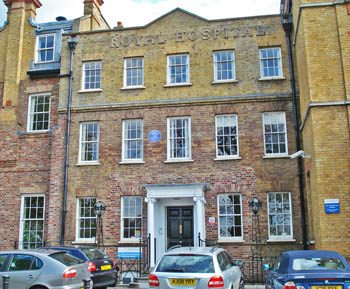
The former main entrance to the Royal Hospital Richmond. This part of the Hospital is Grade II listed. The original 18th century 5-bay house is now embedded in the extensions built on both sides during the 19th and 20th centuries.
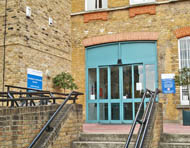
The current main entrance to the Richmond Royal Hospital.
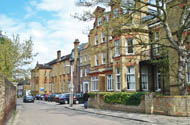
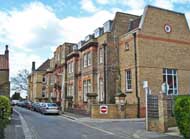
The Kew Foot Road frontage (left) and the Shaftesbury Road frontage (right).
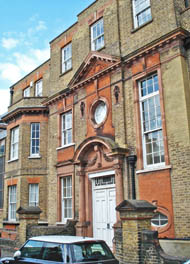
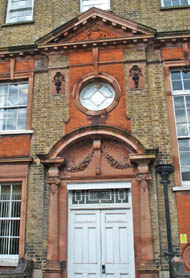
The entrance in Shaftesbury Road.
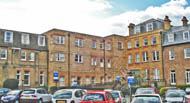
The interior courtyard.
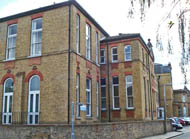

The Evelyn Road frontage (left). A new building off Evelyn Road (right).

James Thomson (1700-1748)
The Scottish poet and playwright James Thomson, who wrote the lyrics to 'Rule Britannia' in 1740, a year after he moved into the cottage.
After his death in 1748 the cottage was sold to his friend, George Ross, who enlarged and improved it, and gave it the name Rossdale. Over the years this was corrupted to Rosedale. The property was acquired in 1786 by Mrs Frances Boscowen, widow of the Admiral. When she died in 1805, the 6th Earl of Shaftesbury bought the house. The Dowager Countess of Shaftesbury died there in 1865 and, in 1868, the hospital committee bought it to use for the Richmond Infirmary.
Thomson's monument in Poets' Corner, Westminster Abbey, is next to that of William Shakespeare.
(Author unstated) 1868 The Richmond Infirmary. British Medical Journal 1 (371), 125.
(Author unstated) 1870 The Richmond (Surrey) Infirmary. British Medical Journal 1 (479), 248.
(Author unstated) 1896 The Royal Hospital, Richmond. Nursing Record and Hospital World, 18th July, 47.
(Author unstated) 1902 Thirty-fifth Annual Report of The Royal Hospital. Self-published.
(Author unstated) 1903 The Royal Hospital, Richmond. British Journal of Nursing, 12th September, 210.
(Author unstated) 1904 Reflections. British Journal of Nursing, 16th July, 56.
(Author unstated) 1907 Reflections. British Journal of Nursing, 19th May, 407.
(Author unstated) 1917 List of the various hospitals treating military cases in the United Kingdom. London, H.M.S.O.
(Author unstated) 1923 Hospital World. British Journal of Nursing, 10th March, 156.
(Author unstated) 1932 Sixty-fifth Annual Report of The Royal Hospital. Self-published.
https://en.wikipedia.org
https://commons.wikimedia.org
https://discovery.nationalarchives.gov.uk
https://historicengland.org.uk
www.britishlistedbuildings.co.uk
www.nhs.uk
Return to home page